Cimarron Tom Horn Winchester 1876 Review - Firearms News (original) (raw)
A Review of Cimarron's 1876 Centennial “Tom Horn” Lever-Action Rifle in .45-60. Plus, an Interview with Actor and Friend of Steve McQueen, Mel Novak!
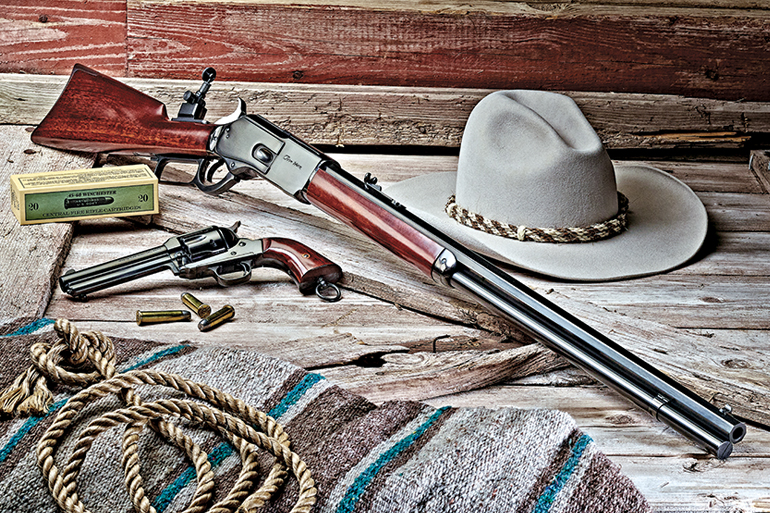
The Cimarron 1876 Centennial “Tom Horn” Rifle chambered in .45-60 is the ultimate addition to any western gun collection. Cimarron, and their affiliate company Texas Jack (TexasJacks.com), also offer other western-style guns and accessories like this Remington 1890 replica revolver which is the same type that was carried by Tom Horn ($624.48), Tom Horn hat ($514.00), and replica ammunition box ($6.30). (Photo by Mike Anschuetz)
May 04, 2020
Spoiler alert — You know the deal. You’ve been warned. Tom Horn was Steve McQueen’s penultimate film. Based upon a true story, the movie’s eponymous central character is a brooding loner with a dark past whose sense of frontier morality puts him in conflict with the progressive social ideals of the day. In many ways Tom Horn is actually Steve McQueen and vice versa. The two men experienced tremendous hardship and tragedy but ultimately faced the end at peace.
The film Tom Horn is as much about a rifle as a man. While not necessarily historically accurate, the film narrative orbits around Tom’s unique Winchester. A massive Model 1876 chambered in .45-60, the unusual particulars of this weapon ultimately condemn Horn to death.
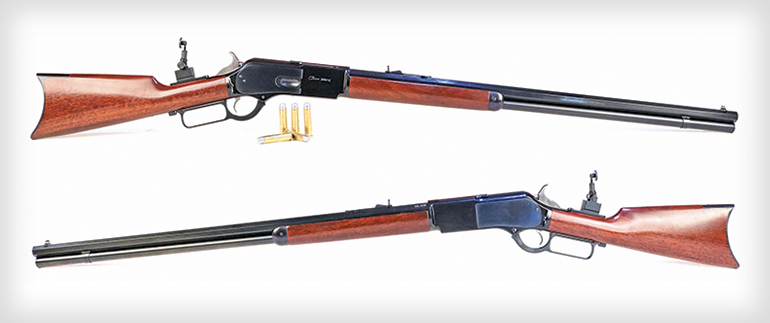
The plot of the movie Tom Horn turns on the character’s Model 1876 Winchester. This unusual rifle and the rare cartridge it fired ultimately tied McQueen’s character to a murder he did not commit.
Most historians state that the real Tom Horn’s rifle of choice was a .30-30 Winchester, likely a Model 1892. However, many historians claim that Horn did own a Winchester Model 1876 rifle and a recent discovery of a Winchester 1876 rifle, chambered in .45-60, which was acquired from a museum many decades ago, is now believed to have been owned by Tom Horn. Some of the evidence includes a sling with “JC Coble, Bolser, Wyoming” carved on it — John Coble was the employer of Tom Horn. Colbel also paid for Horn’s funereal costs and had a book published about Horn’s life. A cleaning rod found with the rifle was wrapped with an envelope which had the lyrics of Life’s Railway to Heaven written on it, a song sung at Tom Horn’s funeral. The song was written by Glendolene M. Kimmell, a schoolteacher that Horn was romantically connected with. Did Horn stash the rifle with his girlfriend? Was it used in the murder Horn was convicted of? Did someone else use his rifle? There are still questions unanswered. Adding more confusion to the riddle is the fact that Horn had three rounds of ammunition on him when he was arrested: a .38-40, a .30-40 Government, and a .45-60 (this was in addition to his .30-30 rifle and ammunition). In any case, the Winchester 1876 used in the film has a great deal more character than a Model 1892. Cimarron offers a beautiful spot-on replica of this very rifle chambered in the quirky but powerful .45-60 cartridge.
The Gun
The Model 1876 Winchester was called the Centennial Model as it was released coincident with the American Centennial Exposition. Where the previous Models 1866 and 1873 were chambered for pistol cartridges, the beefed-up Model 1876 was designed to handle the big game rounds of the day.
Advertisement
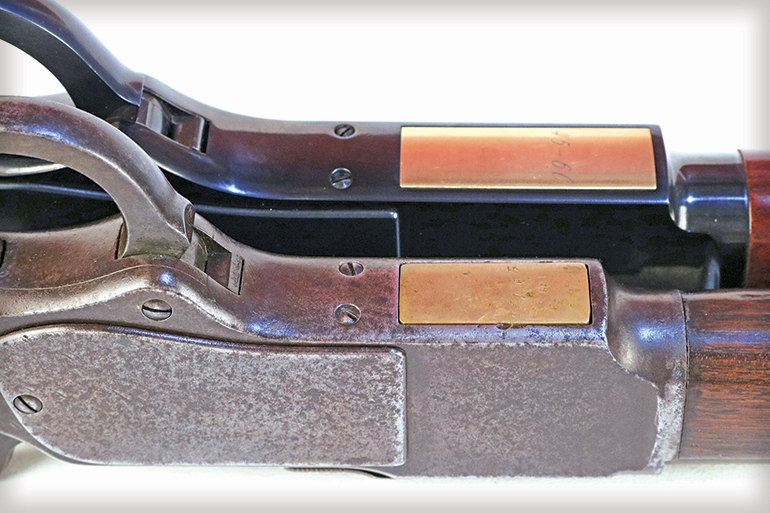
The Cimarron Model 1876 Winchester in .45-60 is shown along-side a vintage original 19th century Model 1873 chambered for the .44-40 pistol round. The differences between the two actions are obvious.
Winchester produced four versions of the 1876 in at least three different chamberings. The Carbine sported a 22-inch barrel, the Express Rifle had a 26-inch tube, and the Sporting Rifle reached out 28 inches. The Musket had a massive 32-inch barrel, before the Model 1886 supplanted it the production run totaled 63,871 copies.
Oliver Winchester was a master marketer. His standard rifles had a blued finish, while the deluxe variants were casehardened. Winchester also offered his famous One of One Hundred and One of One Thousand grades, seven of the former and fifty-four of the latter. The Model 1876 chambered for .50-95 Express was the only lever action rifle to see widespread service among buffalo hunters.
The Canadian North-West Mounted Police bought 750 Model 1876 guns in .45-75 in 1883. The Texas Rangers used the same rifle. President Theodore Roosevelt used a Model 1876 on some of his hunting forays out West and raved about it. Teddy’s copy sported a pistol-gripped stock, a half-length magazine, and extensive engraving. When the famed Apache chief Geronimo was captured in 1886 he was carrying a Model 1876 Winchester.
Advertisement
The Cimarron Tom Horn Rifle
The Model 1876 from Cimarron is a splendid rendition of the gun used in the movie. Featuring a 28-inch octagonal barrel and a 49-inch overall length, this massive lever action tips the scales at just over ten pounds. The steel is blued, and the stocks are a deep stained walnut.
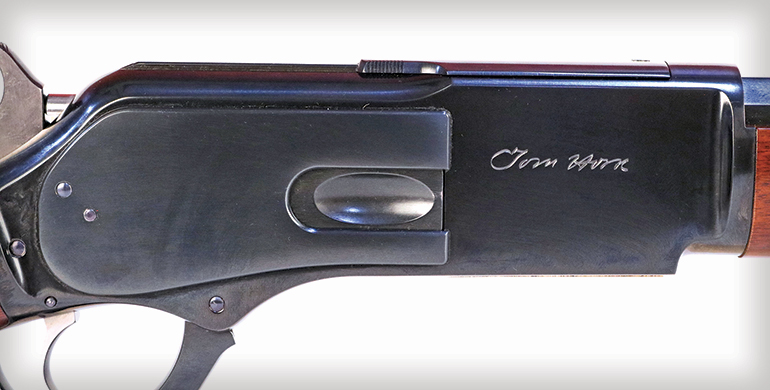
Tom Horn’s signature is engraved across the side of the receiver of this Cimarron Model 1876 Winchester.
Tom Horn’s name is engraved across the receiver. In addition, a removable Marble tang rear sight affixes behind the action and perfectly replicates the setup in the movie. While the actual hero gun used in the film was an original 1882 vintage Model 1876 firing .45-75 WCF — some sources state that this caliber was chosen by the movie production due to availability of .45-70 blanks which would work in the rifle. The Cimarron rifle runs .45-60 in keeping with the movie’s narrative.
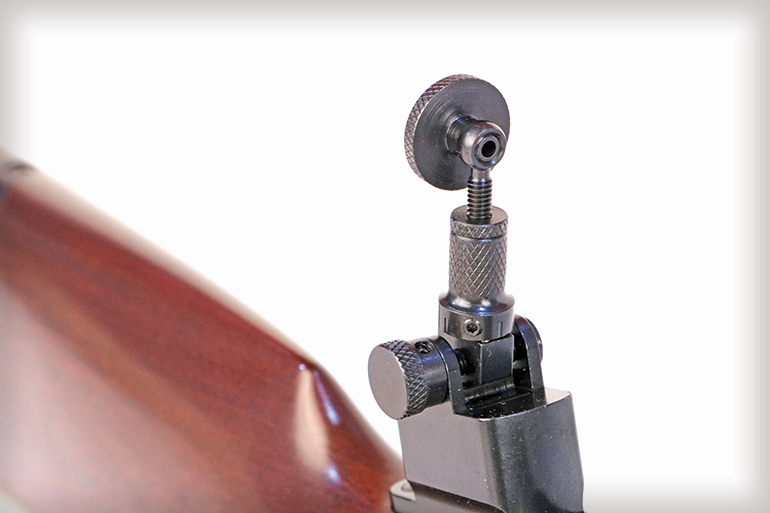
The removable Marble tang sight is a spot-on replica of the one used in the film and gives the big gun plenty of character.
The Cimarron replica is absolutely gorgeous. The fit and finish are flawless, and the action runs like greased glass. At more than four feet long this gun projects authority. For anyone with an interest in period Western firearms the Tom Horn Centennial Model 1876 from Cimarron pegs the awesometer.
How Does She Run?
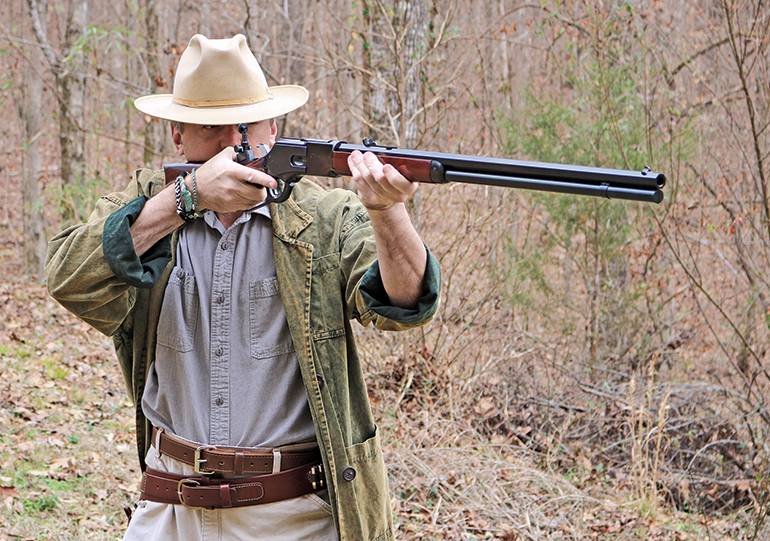
The Tom Horn Model 1876 Centennial is a monster of a firearm. Just hefting the thing will bounce a guy’s serum testosterone up a few notches. The rounds are as big as your index finger, and the elegant angles exude a near-sensual vibe.
Lifting the rifle to your shoulder settles it in place like an old friend. The graceful curved buttplate locks into the human form, while the gentle drop orients the sights right where they should be. The big action runs smoothly and comfortably. However, it did take a few rounds before the action loosened up, and it must be run authoritatively. Lube the firing pin a bit for optimal reliability.
Recommended
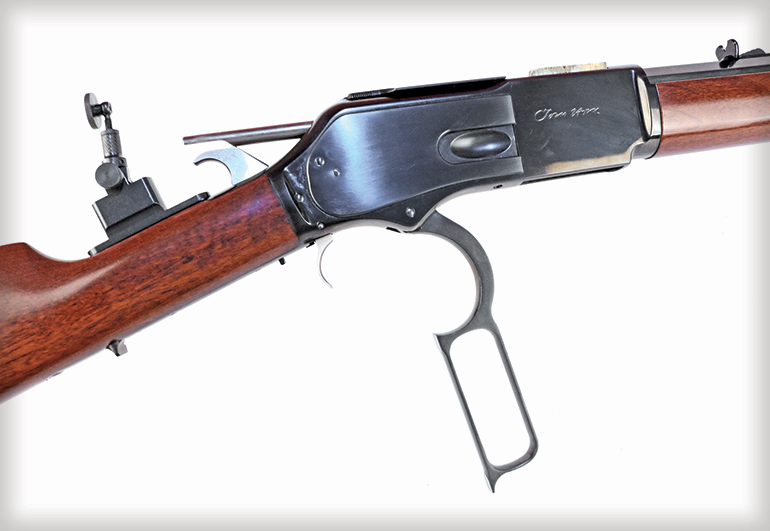
The massive action is designed to accommodate large-bore cartridges like the .45-60.
The rear sight is an adjustable ramp, but that’s not the one you’ll use. The Marble tang sight incorporates an aperture for precision and a vernier adjustment for range. The mechanism folds out of the way when it isn’t needed and slides free for storage. The sight adjusts to compensate for the drop of those big fat lead bullets, but there are no graduations. A man running a rifle this awesome knows his iron well enough not to need them.

.45-60 ammunition is available, but be prepared to pay 50–50 – 50–80 for a box of 20.
The rounds are big, but the gun is bigger. That means the shooting experience remains recreational. This portly rifle rocks back under recoil and cycles as fast as the operator’s rheumatism might allow. The long heavy barrel keeps those big slugs nicely under control.
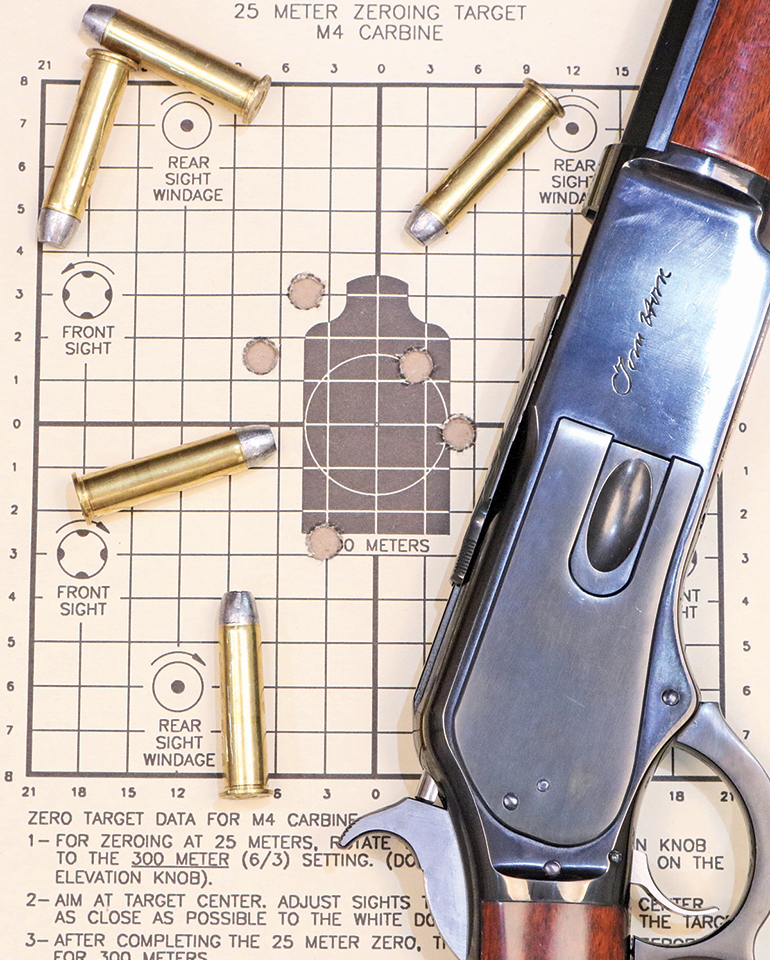
The Cimarron Model 1876 Winchester Tom Horn rifle hits like a freight train downrange. This fifty-yard group could likely be tighter with some younger eyes behind the gun.
Ancillary Iron
Sundry other characters wield Model 1892 Winchester rifles that are period correct for a movie set in 1903. Actor Slim Pickens’ character carries a long-barreled side-by-side 12-bore with exposed hammers. McQueen uses a similar coach gun liberated from a cattle rustler to put paid to another ne’er-do-well.
A variety of rustlers pack the obligatory Colt Single Action Army in several different configurations. Colonel Colt’s Peacemaker is the archetypal Western revolver. Cimarron offers a wide array of these iconic wheelguns.
Horn loses his favorite horse to a brigand armed with a heavy .44-caliber Colt Walker revolver. The Colt Walker was designed in 1846 as a collaborative effort between Texas Ranger Captain Samuel Hamilton Walker and Sam Colt. There were only 1,100 original guns produced, 1,000 of which went to the military. Sam Walker died wielding a brace of his eponymous revolvers while fighting in the Mexican-American War in 1847.

The .44-caliber Walker Colt was the most powerful handgun in the world in its day. (Wikipedia)
One of Horn’s adversaries wields a Smith and Wesson Model 3 Schofield revolver. This single action top-break wheelgun debuted in 1870 and was the first cartridge-firing handgun adopted by the US Army. Bob Ford used a Schofield Model 3 to kill Jesse James in 1882.
Déjà vu
Tom Horn bears a strange resemblance to my personal favorite Western, Quigley Down Under. In fact, Steve McQueen was initially approached about starring in Quigley in the 1970’s. The exigencies of show business intervened, and the movie was not made until 1990 with Tom Selleck and his Shiloh Sharps .45-110 rifle in the lead roles.
There is a pervasive melancholia about Tom Horn. McQueen’s character does some bad things, but he has a good heart. The viewer wants him to prevail. However, the Cattleman’s Association, a timeless personification of faceless greed, ultimately takes his life unjustly. A special gallows was constructed that was activated by Horn’s own weight, no one in attendance being willing to throw the lever.
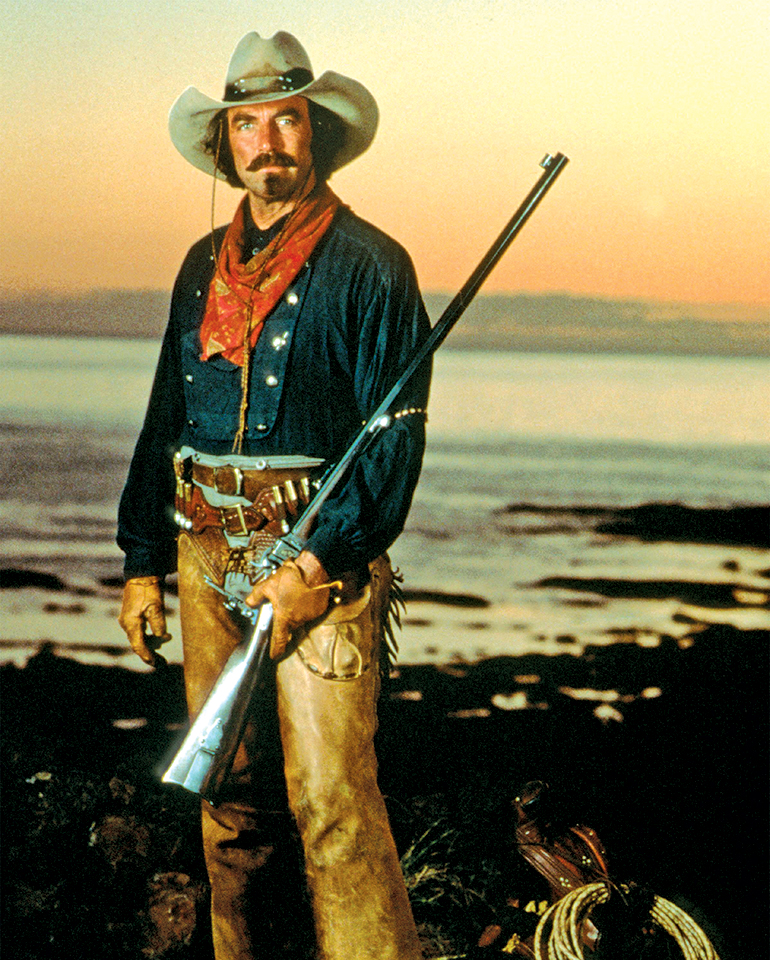
Tom Horn seems oddly similar to the Tom Selleck classic Quigley Down Under. (Moviestillsdb.com)
Tom Horn hit theaters in March of 1980. Steve McQueen died of malignant mesothelioma eight months later at age fifty. The cumulative effects of a terminal disease and McQueen’s Hollywood lifestyle were beginning to take a toll during the making of the film. This toxic combination likely contributed to the movie’s gritty edge.
Denouement
The historical Tom Horn, like the character in the movie, was a frontier Renaissance Man. He served as a civilian scout for the US Cavalry, a ranch owner, a Pinkerton detective, a deputy sheriff, and a “Range Detective.” In the latter role he was essentially a paid assassin who meted out frontier justice to cattle rustlers in exchange for a stipend for every dead outlaw he could produce.
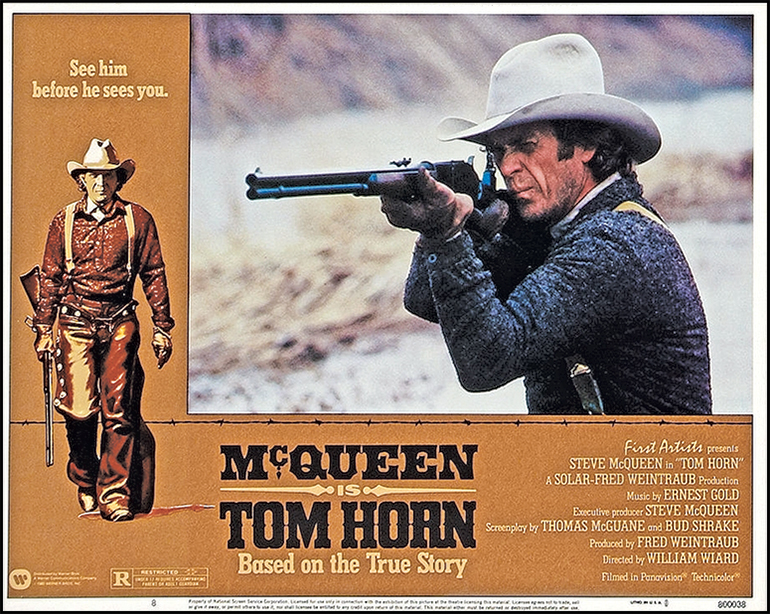
Tom Horn is a Hollywood classic coming at the end of the golden age of Western films. The movie is avail-able to stream for free on Vudu. (Moviestillsdb.com) (Moviestillsdb.com)
Unlike the film’s title character, the real Horn was more morally complex. He likely killed at least seventeen men, the first in a duel over a prostitute. It was his conviction for the murder of a 14-year-old boy named Willie Nickell near Iron Mountain, Wyoming, for which he was hanged the day before his 43rd birthday. The film was inspired by his autobiography The Life of Tom Horn: Government Scout and Interpreter as told by Himself that he wrote while in jail while awaiting execution.
Steve McQueen was in his time the highest paid actor in Hollywood, and he carries a gravitas to which other lesser actors still aspire. The tale of Tom Horn has all the elements of ruggedness, passion, and justice ill-served that make for a compelling Western. Tolerate a few commercials and you can catch it for free on Vudu.
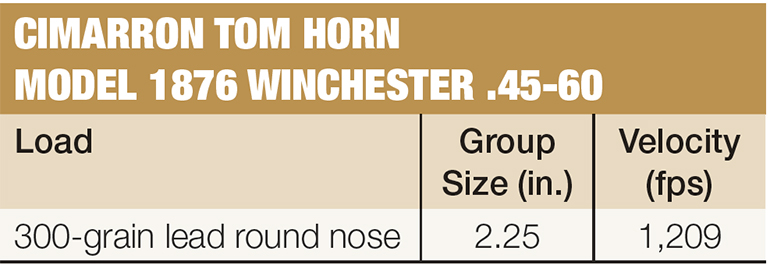
Group size is best four of five rounds fired from a simple rest at fifty yards. Velocity is the average of three rounds fired across a Caldwell Ballistic Chronograph oriented ten feet from the muzzle.
Cimarron Tom Horn Winchester 1876
- Caliber: .45-60
- Barrel Length: 28-inch octagon
- Frame: Blued
- Stocks: Walnut
- Magazine Capacity: 11+1
- Overall Length: 49 inches
- Weight: 10.05 pounds
- MSRP: $1,864.17
- Contact: Cimarron Firearms, (877)-SIXGUN1, Cimarron-Firearms.com
An Interview with Actor Mel Novak
Firearms News Editor, Vincent DeNiro, asked me to reach out to his friend Mel Novak as he acted in the movie Tom Horn. Mel Novak is the veteran of fifty-four movies. A legendary martial artist, he’s died twenty-three times on screen and worked alongside the likes of Yul Brynner, Isaac Hayes, Sybil Danning, and Chuck Norris. He fought Bruce Lee’s character to the death in Game of Death as “Stick” and lived to tell the tale. He was also a friend and spiritual mentor to Steve McQueen.
Mel’s real calling is to serve those society finds the most unlovely. An ordained minister, Mel has for more than thirty-six years led services in prisons and skid row areas reaching the homeless and the incarcerated for Christ. Starting out with a stint playing professional baseball with the Pittsburgh Pirates, that was cut short by a severe shoulder injury, he has gone on to a long career in movies and along the way reached countless souls for Jesus.
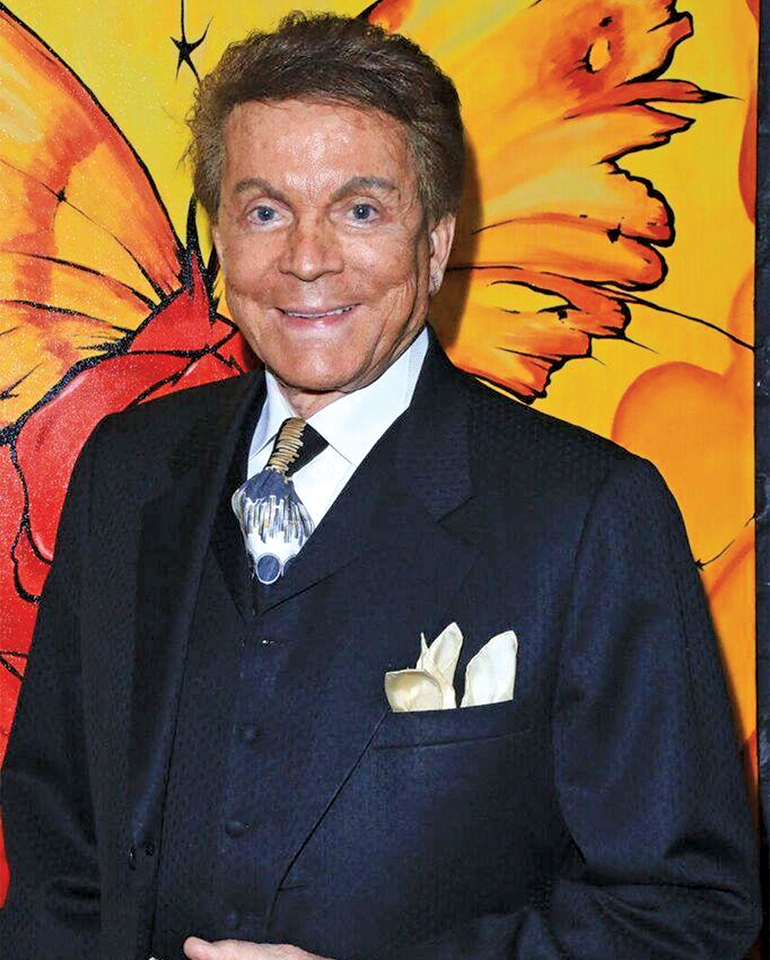
A perennial villain in dozens of familiar action movies, martial arts legend Mel Novak has devoted his life to Christian ministry. (Wikipedia)
WD: Tell me something memorable about Steve McQueen. What was he really like up close?
MN: Steve was a real down-to-earth kind of guy. One day I was out trap shooting with Stephen Spielberg, Ken Hyman, and John Milius when up walks this guy with really long hair and a full beard. Once I saw those bright blue eyes I realized it was Steve. This was maybe seven months before he died. I had first met Steve McQueen, through his karate instructor Pat Johnson, years before at a birthday party.
Coppola and Milius were making Apocalypse Now, and they wanted Steve to play the part of LTC Kilgore. They offered him $2 million on the spot for one week’s work in the Philippines, and he turned him down cold. Steve didn’t have anything else going on at the time, but he just didn’t feel like leaving the country.
WD: Hard to imagine “Charlie don’t surf!” and “I love the smell of napalm in the morning!” coming from anybody but Robert Duvall, but apparently that was almost Steve McQueen. Share with us a memory about making the movie Tom Horn.
MN: The movie was already cast, but Steve fired the director Steve Guercia right after filming began. He got rid of several of the cast members and said he wanted me in the film. I got a call from the producer Fred Weintraub at 3pm telling me I needed to be on a plane for Arizona at six.
The next morning, I went through wardrobe and makeup but still had not seen a script. On the drive out to the set, they told me I was getting a different role with a lot of dialogue, and I still hadn’t seen any of it. As soon as I got there they were ready to shoot.
I said a quick prayer for help, and the new director announced unexpectedly that it was time for a lunch break. I skipped lunch and went back to my trailer to learn my lines. When it was all over Steve was happy with it.
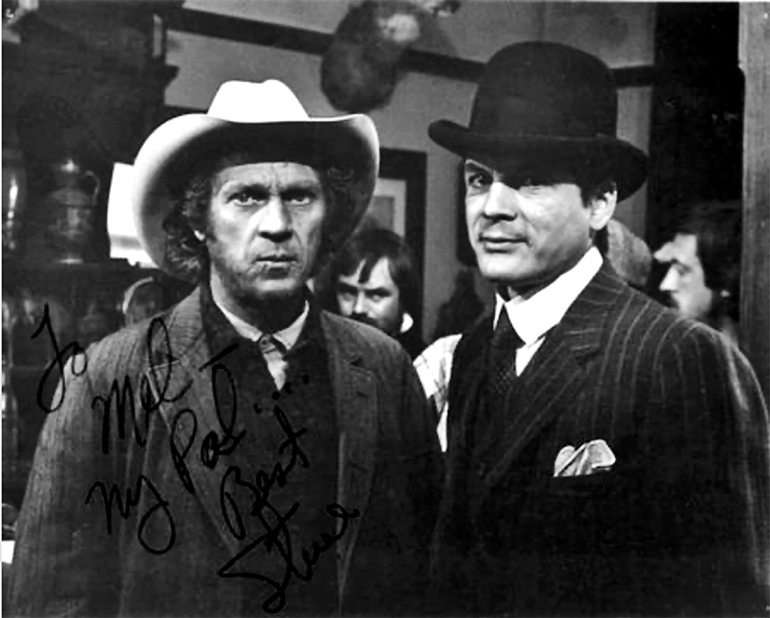
Mel Novak was a friend and spiritual mentor to Steve McQueen. Here is seen on the movie set of Tom Horn. (Photo courtesy of Mel Novak)
WD: Tell us about Steve’s last months.
MN: He had a horrible cancer, but I know Steve McQueen is in glory with the Lord. Billy Graham went down to Mexico to meet with him. I was once giving him some scriptures and he told me, “Mel, you sound just like my pastor.” We both laughed, and I said, “Well, Steve, we read the same book.” I was blessed to know him and to minister to him. He’s someone that you never forget.